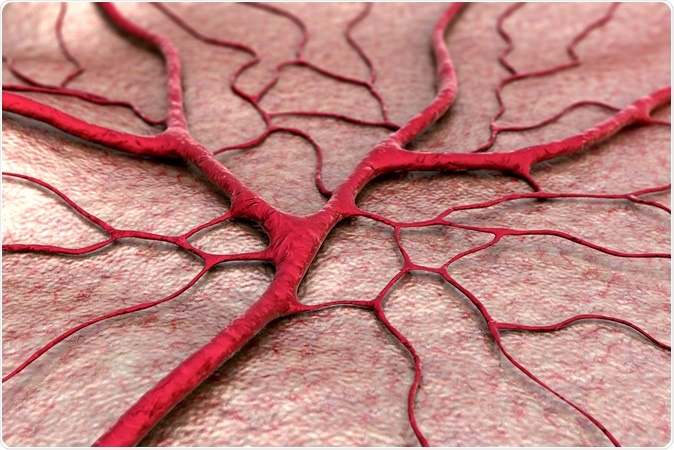Researchers have now successfully created perfect blood vessels in the labs and this may be a huge step in benefitting people with diabetes and other conditions. The report of the procedure appears in a study titled, “Human blood vessel organoids as a model of diabetic vasculopathy,” published in the latest issue of the journal Nature.

Capillary, blood vessel illustration. Image Credit: UGREEN 3S / Shutterstock
The researchers on the team from the Austrian Academy of Sciences and the University of British Columbia, explain that diabetes causes abnormal thickening and damage to the blood vessels. This thickening occurs in the “basement membrane” part of the blood vessel, they explain. Because of this thickening there is impaired transfer of nutrients and oxygen from the blood vessels to the tissues and the cells surrounding it. This leads to the complications commonly seen among diabetics including eye disease, blindness, heart disease, strokes and kidney damage.
The team used stem cells to make them grow on “organoids” to become blood vessels. Stem cells or pluripotent cells in the body have the capacity to turn into any cell given the right triggers. The organoids are the three dimensional structures that are similar to organs. These act as a frame or scaffold for the blood vessels to grow upon.
These lab grown blood vessels are now placed within a petri dish to mimic an environment of diabetes. Soon they found that these blood vessels showed a thickening of the basement membranes. This was similar to what happens to blood vessels of diabetes explained Reiner Wimmer a postdoctoral research fellow at the Austrian Academy of Sciences, who was one of the researchers on the team. The team then looked for a chemical that could prevent this thickening of the membrane and found that an inhibitor of the enzyme γ-secretase could do the trick. Researcher Josef Penninger explained that this inhibition of γ-secretase seemed to prevent the blood vessel damage and this could prove to be a new area of therapy for diabetics.
The team believes that this research would benefit not only diabetes research but also other disease conditions where blood vessels are involved in the disease process. Penninger in a statement said, “Being able to build human blood vessels as organoids from stem cells is a game changer... Every single organ in our body is linked with the circulatory system. This could potentially allow researchers to unravel the causes and treatments for a variety of vascular diseases from Alzheimer's disease, cardiovascular diseases, wound healing problems, stroke, cancer and, of course, diabetes.” Wimmer also said, “What is so exciting about our work is that we were successful in making real human blood vessels out of stem cells... Our organoids resemble human capillaries to a great extent, even on a molecular level, and we can now use them to study blood vessel diseases directly on human tissue.”
Diabetes affects 420 million people across the world and is fast becoming the leading cause of death and disability. Long term diabetes causes damage to almost all the major organs of the body. This is caused mainly due to the persistently elevated blood glucose levels.